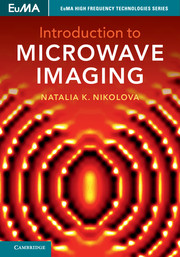Book contents
- Frontmatter
- Dedication
- Epigraph
- Contents
- Preface
- Notation
- Acronyms
- 1 Scalar-Wave Models in Electromagnetic Scattering
- 2 Electromagnetic Scattering: The Vector Model
- 3 Scattering Parameters in Microwave Imaging
- 4 Linear Inversion in Real Space
- 5 Linear Inversion in Fourier Space
- 6 Performance Metrics in Imaging
- 7 Looking Forward: Nonlinear Reconstruction
- Appendix A Maxwell's Equations
- Appendix B Electromagnetic Vector Wave and Helmholtz Equations
- Appendix C Scalarized Electromagnetic Models
- Appendix D Causal, Acausal, and Adjoint Solutions to the Wave Equation
- References
- Index
7 - Looking Forward: Nonlinear Reconstruction
Published online by Cambridge University Press: 08 July 2017
- Frontmatter
- Dedication
- Epigraph
- Contents
- Preface
- Notation
- Acronyms
- 1 Scalar-Wave Models in Electromagnetic Scattering
- 2 Electromagnetic Scattering: The Vector Model
- 3 Scattering Parameters in Microwave Imaging
- 4 Linear Inversion in Real Space
- 5 Linear Inversion in Fourier Space
- 6 Performance Metrics in Imaging
- 7 Looking Forward: Nonlinear Reconstruction
- Appendix A Maxwell's Equations
- Appendix B Electromagnetic Vector Wave and Helmholtz Equations
- Appendix C Scalarized Electromagnetic Models
- Appendix D Causal, Acausal, and Adjoint Solutions to the Wave Equation
- References
- Index
Summary
This book has introduced the reader to the principles of EM scattering theory along with the basic linear (or direct) reconstruction approaches of MW and millimeter-wave imaging. It has been emphasized that the linear reconstruction methods suffer from limitations stemming from the linearizing approximations of the forward model of scattering. The linearized models are incapable of taking into account multiple scattering and mutual-coupling effects. Such effects dominate the scattering in complex heterogeneous objects such as living tissue, luggage items, and structural components in civil engineering.
This is why the forefront of MW imaging research is focused on reconstruction approaches that can tackle nonlinear scattering. Yet, research and development in MW nonlinear reconstruction demand familiarity with the basics of scattering theory and linear reconstruction along with some understanding of the nature of the MW signals and measurements. Familiarity with linear reconstruction methods is especially important because these are often employed as modules in nonlinear inversion strategies.
It is the author's hope that this text has aided the novice on a difficult journey through a thick forest of equations in mathematical physics and an overwhelming gallery of clever inversion techniques to the highly technical subject of MW metrology. By no means is the present text exhaustive. Numerous references have been provided throughout and many more exist in the scientific and engineering literature. MW imaging is a vast and dynamic field of research, and one has to keep an eye on new developments.
But most importantly, it is the author's hope that the reader will continue this journey. The next big step is nonlinear reconstruction. The monograph of Pastorino [46] dedicates special attention to this subject and contains an extensive list of references. The applications of microwaves in medical imaging almost exclusively employ nonlinear strategies. Overviews of these applications can be found in [93, chapter 7], [257], and [134, 135].
Here is a taste of what lies ahead. The nonlinear reconstruction approaches share two common characteristics. First, they are quantitative, i.e., they are, in principle, capable of recovering the complex permittivity distribution of the object under test (OUT). This is a consequence of their second common characteristic: they do not employ linearizing approximations regarding the internal field distribution in the OUT such as the Born or Rytov approximations that we discussed in Sections 1.13 through 1.18.
- Type
- Chapter
- Information
- Introduction to Microwave Imaging , pp. 290 - 296Publisher: Cambridge University PressPrint publication year: 2017

